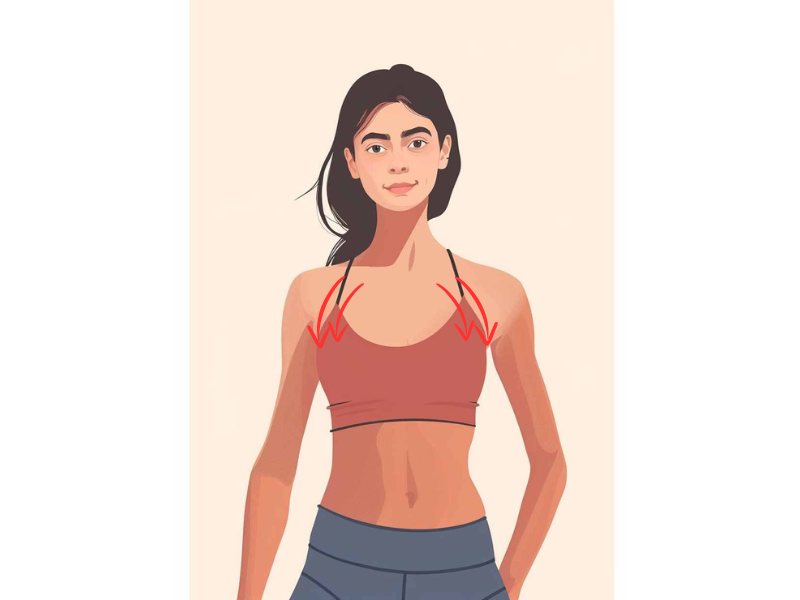Gua sha is a powerful tool in Traditional Chinese Medicine (TCM) that helps promote circulation, reduce muscle tension, and support the body’s natural healing process. When used on the chest, gua sha can offer significant benefits, especially for those experiencing respiratory issues, muscle tightness, or emotional discomfort. Whether you’re looking to relieve chest congestion or improve overall chest health, these gua sha tips will guide you through the process.
If you’re new to gua sha, check out our basic guide to gua sha here to get started.
1. Use Gentle, Outward Strokes to Relieve Chest Congestion
The chest is a sensitive area, so it’s important to use gentle pressure when performing gua sha. This is especially true when you’re working to relieve chest congestion caused by colds, allergies, or respiratory discomfort.
To ease congestion and promote circulation:
- Start in the center of the chest, near the sternum (the breastbone), and use outward, slightly upward strokes toward the shoulders and armpits.
- Keep the gua sha tool at a 30-degree angle to the skin and apply light, sweeping pressure.
- Focus on areas around the collarbone and armpits, which are crucial for lymphatic drainage. These regions house several lymph nodes, and stimulating them can help remove toxins and fluid buildup, reducing chest congestion and swelling.

By incorporating this technique, you can relieve discomfort from congestion while encouraging overall respiratory health.
“For the chest, glide the tool along the area above and below the collarbone and around the ribs to effectively release tension and improve circulation,” says senior TCM therapist Ms. Mai Sogawa.
2. Stimulate Lung Function with Upper Chest Strokes
In TCM, gua sha can help enhance lung function by promoting circulation in the upper chest. Better circulation helps oxygenate the lungs, making it easier to breathe and reducing any feelings of tightness.
To stimulate lung function:
- Begin just below the collarbones and use gentle, outward strokes toward the shoulders.
- Focus on slow, deliberate movements to encourage relaxation and deeper breathing.
- Be mindful of your breath as you perform this technique, aiming for slow and deep inhalations to maximize the benefits.

This practice is particularly useful for those who experience shortness of breath or general tightness in the chest.
3. Relieve Chest Tension by Targeting Pectoral Muscles
Muscle tension in the chest, often caused by stress or poor posture, can be relieved with gua sha. Targeting the pectoral muscles will help reduce tightness and improve overall comfort in the upper body.
To release muscle tension:
- Start just below the collarbone, where the upper chest meets the shoulders, and move the tool downward across the pectoral muscles.
- Use gentle, steady strokes, following the natural contour of the chest toward the armpits and below them.
- Pay special attention to areas that feel tight or sore, working slowly to release the tension.

Incorporating this technique regularly can help improve posture, reduce upper body stress, and promote a sense of relaxation.
4. Support Emotional Health Through Chest Gua Sha
In TCM, the chest is considered a key area for emotional health, particularly grief and sadness, which can manifest as physical discomfort. Gua sha can help release emotional blockages by promoting the flow of energy (Qi) through the chest.
To release emotional tension:
- Start at the center of the chest, just above the heart, and use soft, outward strokes along the rib cage, moving toward the outer edges of the chest.
- Focus on creating a soothing rhythm with your strokes, encouraging relaxation and emotional release.
- Deep, mindful breathing during this technique can further enhance its calming effects.

This method is especially helpful for those experiencing emotional stress or feelings of heaviness in the chest.
5. Pair Gua Sha with Warm Compresses for Enhanced Chest Relief
Adding a warm compress before your gua sha session can enhance its effects by opening pores, relaxing muscles, and improving circulation. This combination is particularly effective for relieving chest discomfort and congestion.
To use a warm compress:
- Place a warm towel on the chest for 5-10 minutes to loosen the muscles and relax the area.
- After warming the chest, perform gua sha using gentle, outward strokes as described earlier.
- This practice encourages deeper relaxation and offers greater relief from congestion and muscle tightness.
6. Apply Herbal Oils to Enhance Gua Sha Benefits
Using herbal oils during gua sha can significantly enhance the therapeutic benefits, particularly for respiratory health and muscle relaxation. Oils like eucalyptus, peppermint, and ginger are great choices for their warming and decongestant properties.
To use herbal oils with gua sha:
- Apply a few drops of your chosen oil to the chest before beginning the gua sha session.
- Eucalyptus and peppermint oils are ideal for clearing airways and supporting respiratory function, while ginger oil promotes warmth and circulation.
- Make sure to test any oil on a small patch of skin before applying it to the chest to avoid irritation.
The combination of gua sha and essential oils can provide deeper relief for both respiratory issues and muscle tension.
According to Ms. Mai Sogawa, “Tools with ridges, curves, and different shapes allow for varied uses depending on the body part. For example, heart-shaped gua sha tools are ideal for covering larger areas, while wing-shaped tools provide precision and targeted treatment.”
7. Practice Gua Sha Regularly for Long-Term Chest Health
To maintain long-term benefits for chest health, consistency is key. While occasional gua sha can provide temporary relief, regular practice will promote better circulation, reduce tension, and support respiratory function over time.
For ongoing chest health:
- Incorporate gua sha into your routine 1-2 times a week.
- Focus on gentle strokes, and pair gua sha with healthy lifestyle habits like deep breathing exercises and good posture.
- Regular practice will help prevent chest congestion, reduce stress, and improve overall respiratory function.
8. Avoid Overworking the Chest Area
While gua sha can be highly beneficial, it’s important not to overwork the chest, as it’s a sensitive area. Excessive pressure or too frequent sessions can cause bruising or irritation.
To avoid overworking the chest:
- Stick to gentle strokes and avoid pressing too hard with the gua sha tool.
- Limit your gua sha sessions to a few times per week to prevent skin irritation or soreness.
- Always listen to your body and take breaks if you notice any discomfort.
By following these gua sha tips, you can help ensure that your chest remains clear, relaxed, and healthy. Whether you’re dealing with congestion, muscle tension, or emotional stress, these techniques can support your overall respiratory and emotional well-being.

Try our Anti-Aging Gua Sha Tool designed to bring out your skin’s natural glow.
Best Gua Sha Product- Anti-Aging: The tool is designed to target 11 specific aging signs such as wrinkles and sagging skin. By following the 7-step routine, users can improve skin firmness and reduce fine lines naturally.
- Enhances Skincare Routine: It works effectively with serums and lotions, boosting absorption and efficacy of skincare products.
- Visible Skin Improvement: Users can expect a smoother complexion, reduced puffiness, and a more youthful appearance.
 P. Sze
P. Sze 

















